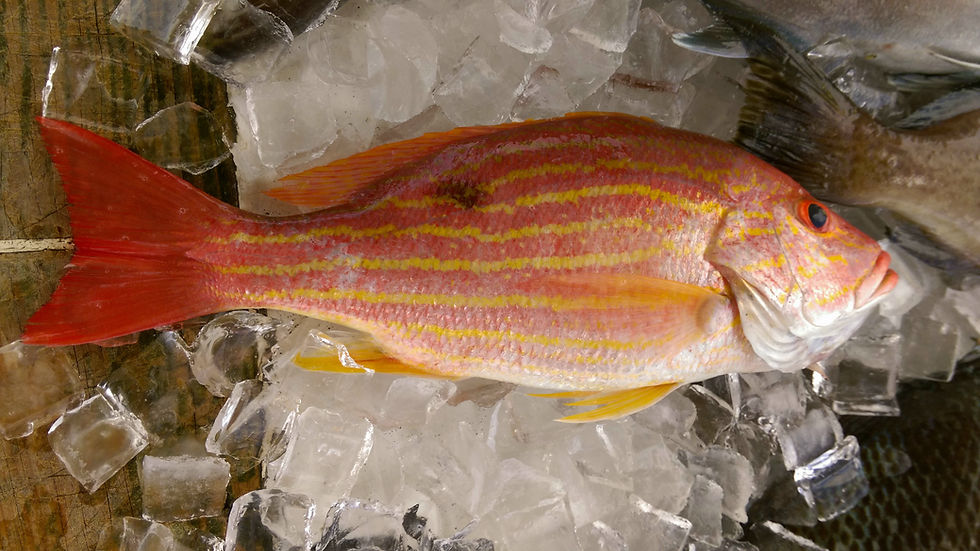Lane Snapper
- Betsy Walker
- Apr 19, 2020
- 3 min read

For as long as I can remember, since starting work at the marina, there has been a friendly rivalry among the fishermen to see who can catch the most lane snapper. I am not sure who is leading the competition right now, but I’d be willing to bet it would depend entirely on who you ask (: D). Lane snapper (Lutjanus synagris) is sometimes called candy snapper, candy striper, Mexican snapper, pot snapper, moonlight grunt or williacke (if someone can explain that last one, please let me know why…cannot find this anywhere).
It has been said that lane snapper can be mistaken for mutton snapper at first glance, but in reality, the coloration of the lane snapper seems to set it apart from most other snapper. Their almond shaped body has a greenish tinge dorsally (top) with pinkish-orange on the upper half fading to a silvery belly and 8 to 10 yellow stripes running horizontally. The lane snapper also has 3 or 4 yellow stripes that run from their snout to their eye, as well as 3 or 4 stripes below the anterior dorsal (front top) rays. There is a diffuse or sometimes indistinct spot under the soft dorsal rays, and all fins have a yellow or reddish-orange color. The lane snapper that inhabit deeper water have a darker and more distinct coloration. They also love beatnik poetry and listen to a lot of Joy Division and Soundgarden (; D).
Normally living about ten years, lane snapper are usually less than 14 inches long and average about one pound; however, they are sometimes caught in deeper water weighing up to five pounds. The Florida state record caught near Pensacola is 6 pounds 6 ounces, and the IGFA record is 8 pounds 3 ounces and 24” caught in Mississippi. The official Louisiana record, requiring a biologist to identify and validate, was a monster lane weighing 10.08 pounds. Wow! Pay attention to this fun fact if you ever go out and try to catch lane snapper. Beware! Many species of snapper shrink or decrease in average length by 3% after catching, so watch out for the lanes on on the smaller end of the legal slot range.
While reading about record lane snapper, I came across an article about measuring the age of fish. Just like the rings on a tree, scientists can count the visible rings on a fish’s otolith (ear bone). National Marine Fisheries did an age-and-growth study where they counted the rings on lane snapper otoliths, and the oldest on record was 17 years old and 20 inches, while the biggest they studied was 11 years old and 27 inches. Amazing! I’d love to know the age of the snapper coming in to the Pensacola Beach Marina!
Living in coastal waters either on smooth bottoms, grass beds, or near structure, like reefs or wrecks, lane snapper do not normally stray form their favorite area for their entire life. You know what lane snapper say, “The grass isn’t always greener.” Normally feeding nocturnally, lanes are opportunistic bottom feeders that eat anything and everything and feed on a array of prey like crustaceans, mollusk and small fish. They are not as wary of hooks as other snapper and will take a variety of bait. Lanes gather in large groups during breeding season, which runs from March through September.
A snapper that is not usually a targeted catch for anglers fishing for red or vermillion snapper, lane are a favorite of the guides at our marina. In an article from Louisiana Sportsman
Jerald Horst said, “If red and mangrove snappers are the meat and potatoes of the snapper fishing world, then lane snappers are the dessert.” Next time you catch a lane, remember the candy snapper is a sweet treat for dinner and you may be the hero of the next big fish tale for the long standing rivalry at Pensacola Beach Marina!
Fish Tales:

Comparison above prepared by: Rebecca Murray and Cathleen Bester and the Florida Museum of Natural History










Comments